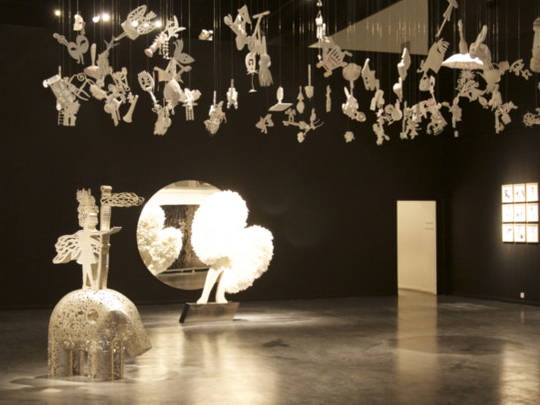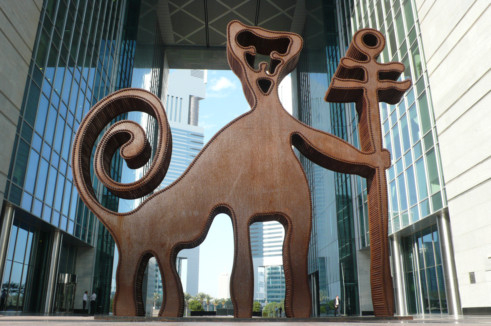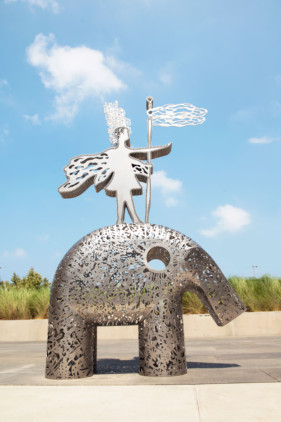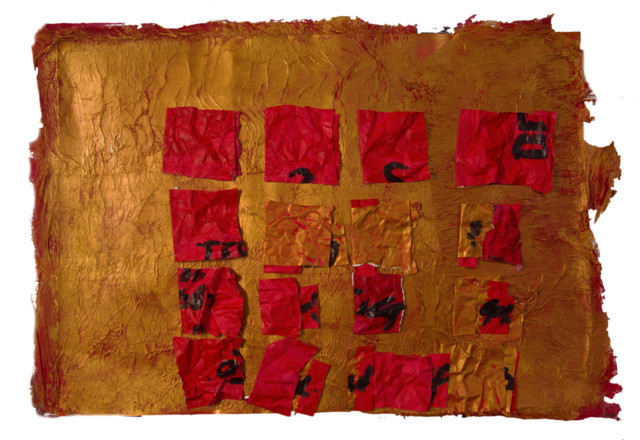
Lebanese artist and architect Nadim Karam’s artistic practices include painting, drawing, sculpture and writing. But he is best known for the public sculptures and installations he has created for various cities around the world. Karam refers to these large-scale steel creations as “urban toys” or “dream catalysts” that are designed to inject an element of playfulness and fantasy in urban environments.
The artist has developed his own visual language, replete with recurring symbols, characters and narratives. And he invites people to use this vocabulary to create their own dreams and stories.
Karam was born in 1957 in Senegal and now lives and works in Beirut. In 1996, he established Atelier Hapsitus. The name is a fusion of the words “happenings” and “situations”, and it is a satellite grouping of young Lebanese architects and designers engaged in creating works that blur the edges between art, architecture and urbanism.
One of his most talked-about proposals is for an architectural piece in Dubai called “The Cloud”. This is a public recreational area shaped like a cloud, perched at a height of more than 250 metres on steel columns. Although the idea proposed in 2007 has found no takers yet, Karam has incorporated into his art the concept of “the cloud” as an amorphous space where any dream is possible.
His latest exhibition in Dubai is titled “99 Objects Possible to Find on a Cloud”. It features several new bodies of work alongside his well-known sculptures and paintings, presenting a comprehensive survey of his recent artistic practice.
The centrepiece of the show is an immersive new installation featuring 99 objects, all painted white, suspended from the ceiling to simulate a cloud. The objects consist of plastic toys combined with Karam’s signature characters and symbols to create crazy combinations that stimulate the imagination and tell myriad stories. The artist’s original drawings of these fantastical objects with humorous titles are also on display.
New sculptures in the show include “Cultural Warrior I: Hannibal and the Elephant”, featuring a warrior riding a delicately carved steel elephant and holding a sceptre topped with a cloud; “Angel’s Share”, which is a surreal winged form made of white feathers and mother of pearl buttons; and a huge work depicting rain brought by clouds. Earlier works in the show include his well-known 2012 project “Closets & Closets”, about war and peace; a series of black-and-white paintings titled “War Series”; a large sculpture titled, “Mutual Agony”; and a set of seven “cloud” sculptures filled with dreams based on different themes.
In an interview with Weekend Review, Karam spoke about his unique vocabulary, his urban toys and the power of dreams. Excerpts:
You talk about creating urban art to help cities dream. What does that mean?
I feel that city life is so fast-paced, mechanical and restrictive, that we have no time to be joyful or “to dream”. My urban toys are “dream catalysts” that stir things up and create some anarchy in the monotonous routine and rigid social and political systems imposed on us, inviting people to pause, look at the stories, interact with them and enjoy some moments of dreaming by creating new narratives. I believe that a city can dream when there is an accumulation of many such “moments of dreams” or ephemeral happenings and situations that I call “hapsitus”, created by different artists.
How do you design urban art for a specific city?
The aim is to go deep into the essence of a city, into the memory of the place and inject stories or moments of fantasy in it through works of art that have some relationship with the city’s culture, history and specific identity and evoke collective memory. But it is also important to bring something new and foreign to the city.
I want my stories to fuse with the existing stories and melt into the context of the city and enrich it. I want to create something that humanises the city by giving it a soul and life. Although I use building materials such as steel in my “urban toys”, they are not intimidating. I make them interactive by using highly polished surfaces that reflect everything around them, and by filling them with fantasy characters that ignite the imagination.
What was the thought process behind proposing “The Cloud” for Dubai?
As an architect I am always trying to challenge myself to create amorphous and ambiguous shapes. A cloud is a perfect example of that. It is ephemeral, nomadic and ambiguous. I see it as a presence that has the potential of being beyond space and time. You can spend hours looking at a cloud and make up endless stories about the ever-changing shapes you see.
When I proposed the idea of “The Cloud” in 2007, Dubai had started going vertical. Many skyscrapers were being built, offering exclusive apartments with great views to those who could afford them. I felt it would be nice to have a structure that is really tall, but accessible to everybody. It would be an iconic presence in the city, parallel to the skyscrapers as a complimentary layer to what Dubai is about. Every resident would be able to say I want to go up to the cloud, and get into the elevators and go up to the gardens and water pavilions and enjoy a nice view of Dubai. As a public platform in the sky, “The Cloud” embodies the essence of Dubai, while also being an antithesis to what is happening in the city.
What does “the cloud” symbolise as an element in your art?
In my art, the cloud comes as an opposition to smoke, which represents war. Clouds are made of water and produce rain; whereas smoke comes from fire, explosions and toxic elements. But there is a stage when smoke looks like a cloud. In this region, we are always between the clouds and smoke in an ambiguous shady area where we are unable to decide how to move forward. In my work, I try to show in different ways this confusing situation where smoke and clouds overlap, and it is for the viewer to extract what they want from it.
For example, in my city, Beirut, despite the smoke of constant strife, life goes on, and people know how to laugh and enjoy life. I believe this enjoyment can be enhanced by art, and also that we must counter destruction with creativity, explosions with dream, and bombs and guns with urban toys. We have to show the younger generation that there is joy in creativity and building something rather than destroying something.
What is the idea behind these 99 objects that can be found on a cloud?
In our region there is a lot of fanaticism, which is represented by a certain symbolism. So I have tried to develop, in my work, a new language with symbols that are free from divisive, emotional and cultural baggage. These 99 objects are small-scale urban toys. Each consists of a real toy, which I found in the market, combined with one of my signature elements to create absurd, whimsical associations.
These objects are about playfulness and festivity. They are trying as much as possible to fragment that fanatic symbol and move it to a subjective level, so that everybody can find their own stories in it. Everyone can relate to elements such as a boy, a girl, a chair, a crib, a robot, a hairbrush or a snowflake. But the funny, paradoxical combinations of these elements offer fertile ground for dreaming. This installation is about questioning whether our fantasies are merely a way of escaping reality, or is it possible to bring this cloud down to Earth and create a parallel reality; and about trying to push the dream to become reality.
Why are the elephant and the couple holding hands recurring elements in your work?
I have been using the elephant in most of my work because I have been able to reach such a simple shape with it and because this animal has a long memory. It provides me a big canvas on which I can experiment and project so many stories and memories. The couple is always together, but always running. They make you think about why they are running and what they are running from. They represent contemporary times where people are forever running from their homes, their countries and various situations.
But this cute couple appears as though they accept where they are going, signifying our ability to adapt to different situations. In some of my paintings they are separated and seen reaching out for each other from two ends of a broken bridge. This is a reference to over 60 bridges that have been destroyed in Lebanon.
What is the connection between Hannibal and the cloud in your new work?
It is an astonishing fact that Hannibal’s army crossed the Alps on elephants. Not only did he dare to go further than anybody else at that time, but his army was also culturally diverse. In this new series, I have visualised him as a cultural warrior carrying a cloud on his sceptre to convey the message that cultural exchange and dreaming is better than war and destruction.
What is the concept behind your acclaimed 2012 work “Closets & Closets”?
It is made up of two sides. On one side are the gleaming “dream closets” with shelves full of fantastical characters such as a couple flying a kite made of a light bulb and flowers; a fisherman, whose fishing rod penetrates the shelves to hook an elephant; giraffes carrying a cloud; and a man with musical instruments in his head.
Each character has its own story and the words written on the shelves articulate various dreams. The other side is the “war” section, with closets made of rusted steel and skewed shelves filled with mangled body parts, bullets, broken objects, army tanks, aircraft being forced to change their flight path and tearful people. Here the “dreamy” words are reshuffled so that they make no sense. Every viewer is invited to stand in front of the mirror separating dreams and war, and reflect on which side they want to choose in life.
The show will run at Ayyam gallery, Al Quoz until November 28.
Jyoti Kalsi is an arts enthusiast based in Dubai.
“Traces” is presented by 1x1 Art Gallery and will run at Empty 10, Al Quoz until November 16.





